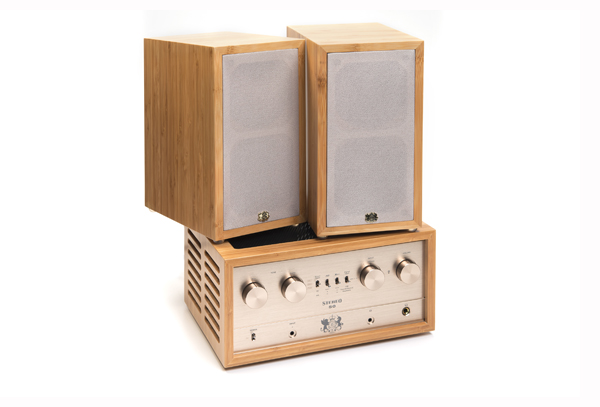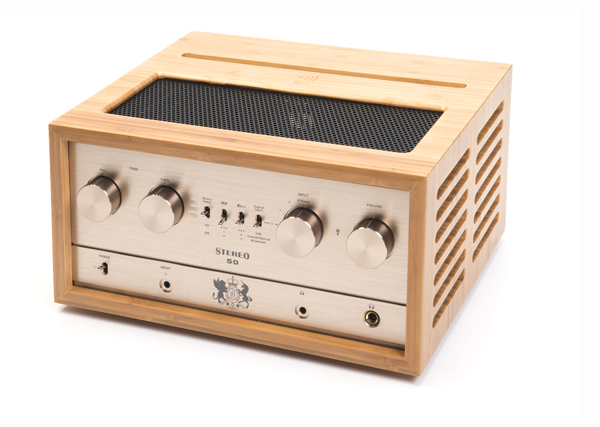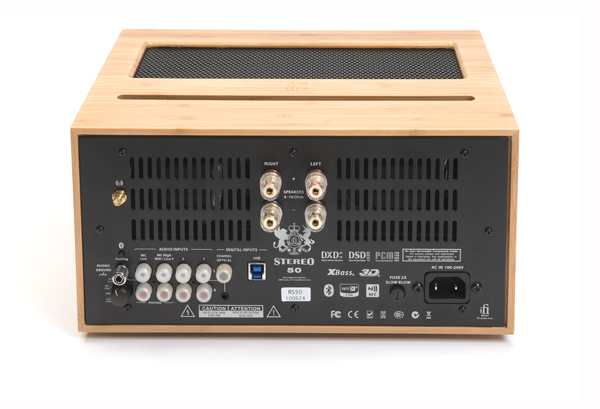Knowing that a quartet of EL-84 tubes lurk under the hood of the iFi Retro 50, I knew it was time to break out the JBLs – and it was good. Just as with the Dynaco SQA-35 and even the Manley Stingrays, there’s just nothing like the sound of a pair of JBL L-100s driven by an EL-84 amplifier. Those little tubes have a soft-spoken magic about them that can’t be duplicated by the EL-34 or even an SET amplifier. And the slightly soft character of this output tube goes miles towards taming the upper register of the L-100s.
Listening to the bongos bounce around the listening room during the opening of Curtis Mayfield’s “Pusherman” is delightful, and when his voice folds into the mix, it comes across much larger than life. If I didn’t know better, I’d swear the Retro 50 was something that has been in a box for 50 years, the dust just shaken off. It really does groove, with an abundance of musical detail as well – it doesn’t just round all the transient attack off to sound groovy. The sound is just more saturated throughout.
Regular readers of TONEAudio know that we’ve given iFi’s compact DAC and phonostage rave reviews. They pack major performance in a small form factor and keep the price down as well. So far, we’ve seen no downside to any of their products that we’ve sampled. The Retro 50 has both of these and a great headphone amplifier – all on this compact chassis, encased in a bamboo enclosure. Now that’s something you never saw on a vintage receiver from the ’70s!
The Retro 50 comes packaged with a pair of iFi’s Retro 3.5 speakers for $1,995. Unfortunately at this time, you must buy the combo; the Retro 50 is not available by itself.
Investigating those little speakers
iFi calls the speakers accompanying the Retro 50 “Retro 3.5” in homage to the legendary LS3/5A BBC monitors. The similarity to the LS3/5A ends with the form factor. They don’t really suck, but they don’t really rock either. Judicious use of the tone controls and signal processing at your disposal on the front panel of the Retro 50 mitigates this, but they perform much better in a desktop system than out in the listening room. Sold alone, they carry a retail price of $795 – forget about them at this price, but as part of the Retro 50 system, not bad.
Fortunately, the Retro 50 is so undervalued, even if you throw the speakers out, it is still more than worth the $1,995 that’s asked. $1,500 for the Retro 50 alone would be the audio bargain of the 21st century, maybe forever!
Even after a lot of break-in time, the Retro 3.5 speakers still sound small. Discerning use of the tone controls and the 3D sound processor help tremendously, yet using them in a room much larger than 11 x 14 feet for anything more than background fill is not suggested. Nearfield in my small second listening room is pleasurable, but the speakers still sound overly polite, without having the body that a real pair of LS3/5As possesses.
The best place for the Retro 3.5s proves to be on the desktop, flanking a 27-inch computer monitor, with a slight tip-up. A bit of toe-in goes a long way, looking for a balance between soundstage width and bass reinforcement. iFi makes it painless for the audio enthusiast to get down to business with audio, USB and speaker cables included in the box. Obsessed audiophiles will want to upgrade these later, and the Retro 50 responds well to a premium wire upgrade.
No matter how you enjoy music, you’re covered
Whether digital, analog or wireless, the Retro 50 can handle your source components. In addition to a cracking MM/MC phonostage and DAC, there is an antenna to stream digital files via your smart device, too. For the foreseeable future, the Retro 50 is “obsolete-proof.”
The Retro 50 is capable of decoding both DSD and DXD files, and this was the only part of the Retro 50 that I did not explore. With all the rage surrounding this, I just can’t get conned into buying my favorite music again. But for those of you who are new to the game and investing in these files, you are good to go. If the 24/192 performance of the Retro 50 is any indication, you will not be disappointed with DSD reproduction.
The coaxial and optical digital inputs accommodate files up to 24/192, while the USB input goes all the way up to DSD 512. With 24/192 files, it is virtually a dead heat between the inputs in terms of sound quality, so whatever strikes your fancy will work well. The gadget geeks in the audience will appreciate the digital input logo changing color with file resolution, just like AudioQuest’s Dragonfly. iFi’s choice of the aptX codec is a great move, so those using other than Apple iDevices will be very happy. Streaming from a Galaxy phone over Bluetooth is stunningly good with Tidal, and for this writer, all I’d ever need on a desert island are the Retro 50, a pair of JBL L-100s and a Galaxy phone with a Tidal subscription (along with good reception, of course!).
Inputting via analog sources works equally well for those feeling more traditional. The phono section of the Retro 50 is identical to that of the iPhono that Richard Mak reviewed here. It’s worth noting that separate MM and MC inputs with 50 and 62 dB of gain are offered, proving perfect for the AVID Ingenium turntable with two tonearms – one utilizing an Ortofon SPU cartridge and the other a vintage Ortofon VMS20 Mk.II. As Mak found in his review of the iPhono, this phonostage is quiet, dynamic and tonally correct. I also had excellent luck with the Denon 103r, Ortofon 2M Black and Grado Statement cartridges. Unfortunately, the Retro 50’s phonostage does not offer the gain and loading adjustments of the iPhono, but only so much can fit on this small chassis. Regardless, it provides an excellent avenue for your vinyl journey.
Further listening
The Retro 50, regardless of input, is dead quiet. Even with ears placed right against the tweeters, there is no noise or tube rush coming from the speakers. Though the Retro 50 claims 25 watts per channel, considering that most other amplifiers designed around a pair of EL84 tubes produce about 15–17 watts per channel, I’m guessing the numbers here are slightly optimistic.
What is important is the quality of the sound that the Retro 50 does produce. Regardless of speakers used from the $88,000/pair Dynaudio Evidence Platinums all the way down to my JBL L-100s, the extended high end and LF control is surprisingly good. By contrast, a vintage Dynaco SCA-35 (also using a pair of EL84s per channel) sounds extremely soft and much noisier. Because the iFi uses a more modern implementation of the circuit and a beefier power supply than my SCA-35, it sounds louder, even though both hit the same sound pressure level. Remember, volume is the difference between loud and quiet, so while the Retro 50 may not actually produce 25 watts per channel, because it is incredibly quiet, it sure sounds like it puts out that kind of power.
This amplifier is all about quality and delicacy. Regardless of the speakers you choose, the Retro 50 conjures up a soundfield that is both wide and deep. Tracking through Neu! is an amazing exercise in trippiness, with cool sound effects all over the room as if you were nestled in between a six-foot-tall pair of headphones.
The Retro 50 doesn’t so much color the lush midrange as maximize texture and tonal saturation. This amplifier is perfect for listening at low to moderate levels.
Acoustic guitars have an extra dash of ambience and thickness about them. Listening to the snap of the acoustic guitar on the title track of Michael Hedges’s Aerial Boundaries is simply breathtaking. And, of course, solo female vocals are incredibly sexy as well.
Perfect for personal fidelity
Auditioning a small cache of headphones also proves the Retro 50 fabulous. Thanks to its 3D holographic image processor (with three settings) and XBass processor, you can fine tune your headphone experience. The Audeze and OPPO phones sounded the most natural with no processing applied, but with some lower end Grados and a few in-ear phones, the option for extra bass really came in handy. The 3D processor was fun, but it felt more like a slight sampling of an illegal substance rather than realistic. And for some that will be a good thing – sample to taste. Fortunately the Retro 50 gives you plenty of options, along with a very useful bass and treble control.
Whether you find joy in this ability to alter your system’s playback with loudspeakers is up to you, but it is wonderful that iFi has included them, especially at this price. The only thing lacking a bit is the aesthetics. The bamboo casework is a home run, but the front panel, printing and control knobs are slightly cheesy, reminiscent of early Chinese hifi – and not a reflection of the sound quality inside the box. I’d happily pay an extra 100 bucks for an upgraded front panel, but that’s my inner interior designer screaming for order.
Like every other iFi product we’ve used or reviewed, the Retro 50 screams high performance and high value – more than worthy of one of our Exceptional Value Awards for 2015. Whether you use the speakers or give them to a friend, the Retro 50 is one of the greatest combinations in the audiophile world today. I can’t think of a better place to start your high end audio journey.
iFi Retro 50
MSRP: $1,995 (with Retro 3.5 speakers)
PERIPHERALS
| Analog source | AVID Ingenium turntable w/SME 3009 and 309 tonearms Denon 103 Ortofon SPU VMS Mk. II cartridges |
| Digital source | OPPO 105 (as transport) MacBook Pro |
| Speaker | JBL-L100 Dali Rubicon 2 Dali Epicon 8 GamuT RS5 |
| Cable | Cardas Clear Light |

















